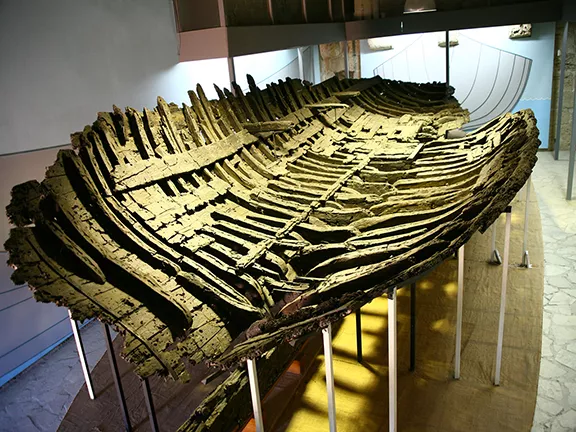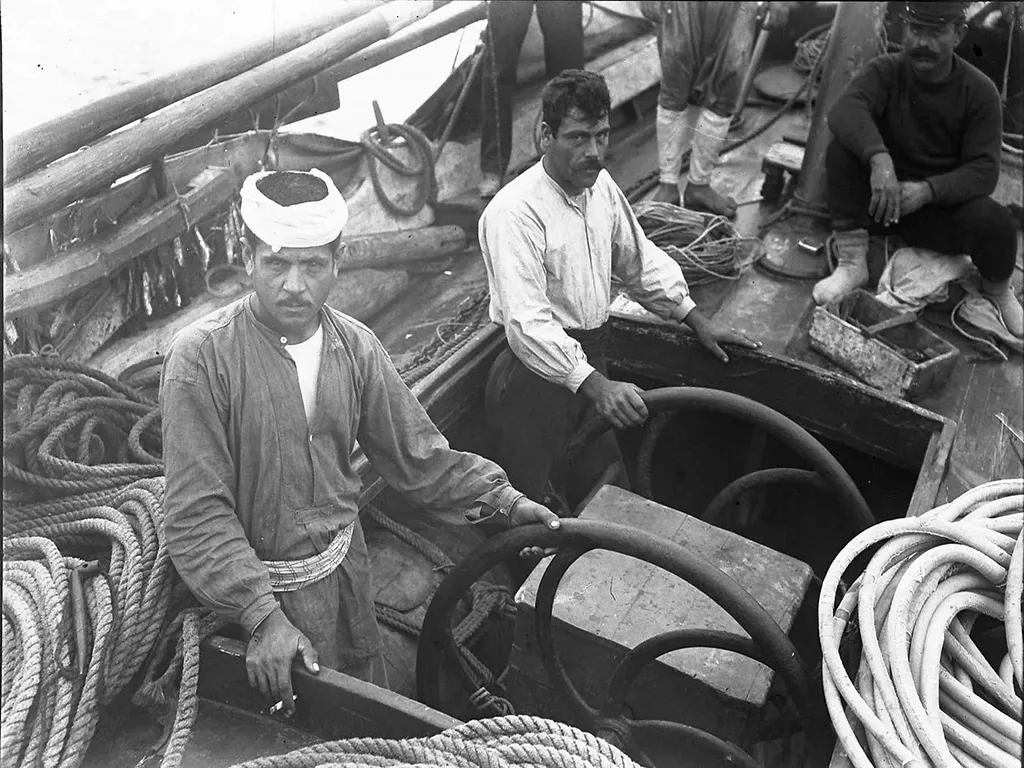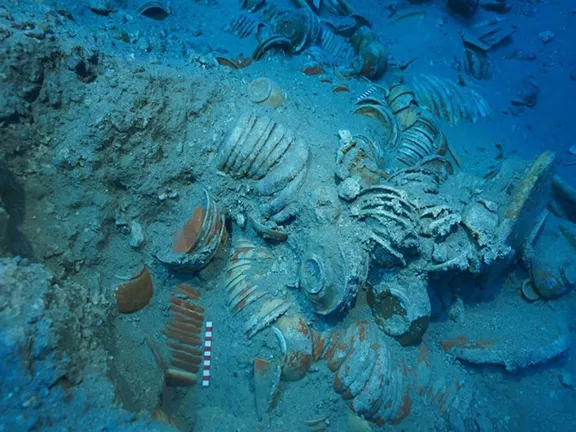Roman Era Shipwrecks in the Mediterranean
Ancient Greek Shipwreck Discovered Off Komiža, Croatia
A 4th-century BC Greek merchant ship found off Komiža, Croatia in 2023, reveals insights into ancient Adriatic trade, shipbuilding, and daily life through its remarkably preserved hull and cargo of amphorae, pottery, and more.
By Nick Nutter on 2025-07-11 | Last Updated 2025-07-16 | Roman Era Shipwrecks in the Mediterranean
This article has been visited 1,645 times

Credit: Screenshot, Underwater Archaeology Department of the Croatian Conservation Institute
The Komiža Shipwreck (400 – 300 BC)
A remarkable 4th-century BC Greek shipwreck was confirmed in 2023 off the coast of Komiža, near the island of Vis in Croatia. This discovery is considered one of the oldest and most significant shipwrecks ever found in the Adriatic Sea. Jurica Bezak, a lead archaeologist with the Croatian Conservation Institute, calls the find ”unique”.
Do you enjoy my articles? For your reading pleasure, this website does not carry third party ads. You could help me write more articles by buying me a cup of coffee.
Discovery and Confirmation
The wreck was initially spotted in 2023 at a depth of 30 to 50 metres. Experts from the Underwater Archaeology Department of the Croatian Conservation Institute have since confirmed its extraordinary historical value. Diver Marko Lete first saw the site. He found a coin and pottery, which helped date the wreck. “Some items look as if they were made yesterday,” Lete said. Human remains were also present.
Dating
The artifacts found, particularly the pottery and a coin still undergoing analysis, strongly indicate a 4th-century BC origin. This period is crucial as it coincides with the establishment of Greek colonies like Issa (modern-day Vis) and Pharos (on Hvar) in the Adriatic.
Construction of the Komiža Shipwreck
What makes this shipwreck truly astonishing is its state of preservation. Archaeologists have uncovered a remarkably intact section of the ship's wooden hull, including well-preserved lead plating, as well as fine Hellenistic pottery, personal belongings, and even the forearm of a human. The level of craftsmanship and the clarity of the preserved structure have amazed researchers.
Cargo
The ship is believed to have been a merchant vessel carrying supplies for the newly established Greek colony of Issa. Its cargo included:
Amphorae: A large number of Chian amphorae, likely containing wine, formed a significant part of the cargo. Over 500 Chian amphorae were visible during the initial survey.
Fine ceramics: Exquisite Hellenistic pottery was also found.
Containers: Fine pottery, olive oil, spices, and preserved food containers were also aboard.
A bronze coin: One side depicts a human head, the other side is an impression of a goat.
These findings provide invaluable insights into the daily life, trade practices, and maritime networks of early Greek settlers in the Adriatic.
Significance of the Komiža shipwreck
This shipwreck offers direct physical evidence of the advanced shipbuilding and extensive trade routes of the 4th century BC. It provides a rare connection to the seafaring practices and daily lives of ancient Greek colonists in the Adriatic Sea.
The archaeologists working on the wreck hope to eventually pinpoint its demise to within fifty to one hundred years which would provide them with insights into the colonisation and trade networks between Syracuse and its colony,Vis as well as between Paros and Hvar Island.
Ongoing Research
The excavation and research at the site are ongoing and are expected to continue for several years due to the complexity and delicate nature of the preservation process.
The Croatian Conservation Institute leads the ongoing work with local diving clubs and the Vis Heritage Museum helping them.
Future Display: Many of the recovered artifacts, once restored, will be displayed in the Vis Island museum, thus benefitting the local community. Updating this Article: It is too early to expect any peer reviewed research papers about this wreck. As more information comes to light this article will be updated.
Do you enjoy my articles? For your reading pleasure, this website does not carry third party ads. You could help me write more articles by buying me a cup of coffee.
 2: Kyrenia Shipwreck 295 – 285 BC
2: Kyrenia Shipwreck 295 – 285 BC 3: Marsala shipwreck (c 250 BC) Sicily
3: Marsala shipwreck (c 250 BC) Sicily 4: Mahdia Shipwreck 80–70 BC
4: Mahdia Shipwreck 80–70 BC 5: Antikythera Shipwreck 60 - 50 BC
5: Antikythera Shipwreck 60 - 50 BC 6: Adrasan Plate wreck c 50 - 20 BC
6: Adrasan Plate wreck c 50 - 20 BC